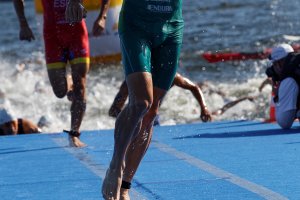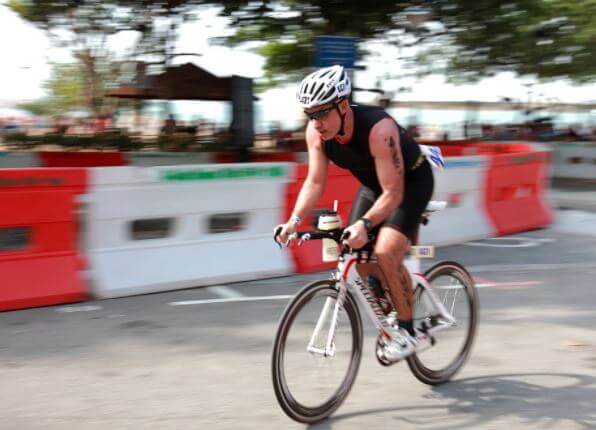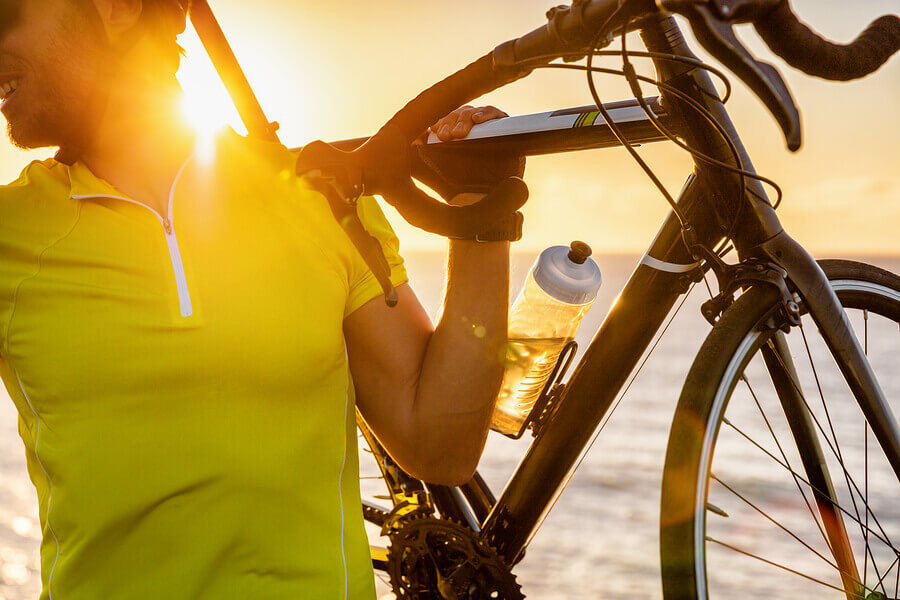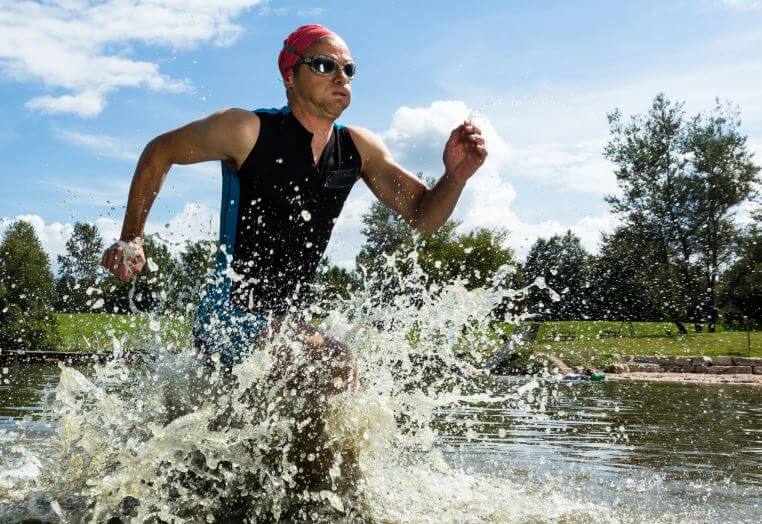Tips for Triathlon Transition: How to Ace your Next Race

Many triathletes are so focused on swimming, cycling and running, they sometimes forget that the clock is also against them in the transition area. Every passing second matters, so in this article, we’re going to tell you the best triathlon transition tips to keep you ahead of the game.
Triathlon transition: definition and importance
What exactly are we talking about?
For those that aren’t familiar with it, each triathlon has a special place, called a transition area, where participants change clothes and do whatever is necessary before moving on to the next stage.
It’s true that the transition zones are not as fun as the competition itself, but it still requires you to plan for it in your training.

Transition is not a moment of rest, but a place to accelerate entry and exit, spending less energy. As a triathlete, you’ll prepare for swimming, cycling and running, but it’s likely that you’ve not even considered transitions.
Without a doubt, failing to prepare is one of the most common mistakes first-time triathletes make. If you do forget to plan for transition areas, this will add seconds of your total time. In fact, failing to comply with these basic tips for triathlon transition could throw your race out of the window!
The best tips for triathlon transition areas
No matter the level you are currently in, there’s no excuse for being slow or wasting time in the triathlon transition zones. The time you take between the swimming, cycling and running sections goes hand in hand with your skill level and your talent.
Fear no more. Today is all about letting you know our best tips and tricks to ace your next triathlon transition! Here’s what you should know about it:
1. Choose the right location
The first of the tips for triathlon transition zones is to select your location beforehand if at all possible. To know if you can do this or not, ask the protocol team about it.
If you can choose your own place, look for one at the end of a row and near the exit. This is usually a good place to get your bike out while spending minimal time dealing with other participants.
Once you have selected your location, mark the place. This means making it visually distinctive. You could tie a balloon, put a handkerchief, a flag or even a ribbon or a bright towel. Even though you might think you could never forget where your spot is, it happens.
Do a mock race and come from the previous section and into the transition zone. Memorize the path from the race to your place.

2. Visualize the transitions
This helps to prepare your mind to know what to do even in the middle of the race. On the day of the race, you should arrive with enough time to inspect the transition area and, if possible, make your routes and departures so you know exactly where to go.
Before the race, you should walk around the transition area and visualize the entrance and exit areas of the bicycle.
Rehearse each section on foot from where the bicycle is mounted. Imagine what you’ll be thinking and how the area will look when there are hundreds of bicycles and people there. Become familiar with the transition area and make sure your equipment is properly configured.
3. Plan ahead
Although it seems impossible, it’s common to see less experienced athletes forget one or more essential elements for the race and not realize it until the moment when they need it! To prevent this from happening, we recommend you plan in advance all of the appropriate equipment necessary for the triathlon.
This means that the night before you should pack your bags with all the necessary elements: protective goggles, energy bars, clothes, etc. There’s no need to transport multiple accessories; you just have to make sure you keep your needs to a minimum but covered.
Make this easier with a visualization exercise: do the race in your head and note every item you’ll need at each phase. Then all you have to do is pack!
4. Don’t waste time in transition
Our final triathlon transition tip is a simple one: don’t waste your time!
Although it’s perfect if you want to take the opportunity to rest, you have to remember two aspects. The first is that your transition time counts in total time.

On the other hand, don’t forget that there’s probably someone behind you. If you’re going to walk or slow down at any time, move to the side so that runners who want to run can maneuver around you.
As we noted, most triathletes spend most of their training time focused on the three main events: swimming, cycling and running. However, the transition between each event also requires preparation. We recommend you consider the above tips to improve your own records. You can do it!
Many triathletes are so focused on swimming, cycling and running, they sometimes forget that the clock is also against them in the transition area. Every passing second matters, so in this article, we’re going to tell you the best triathlon transition tips to keep you ahead of the game.
Triathlon transition: definition and importance
What exactly are we talking about?
For those that aren’t familiar with it, each triathlon has a special place, called a transition area, where participants change clothes and do whatever is necessary before moving on to the next stage.
It’s true that the transition zones are not as fun as the competition itself, but it still requires you to plan for it in your training.

Transition is not a moment of rest, but a place to accelerate entry and exit, spending less energy. As a triathlete, you’ll prepare for swimming, cycling and running, but it’s likely that you’ve not even considered transitions.
Without a doubt, failing to prepare is one of the most common mistakes first-time triathletes make. If you do forget to plan for transition areas, this will add seconds of your total time. In fact, failing to comply with these basic tips for triathlon transition could throw your race out of the window!
The best tips for triathlon transition areas
No matter the level you are currently in, there’s no excuse for being slow or wasting time in the triathlon transition zones. The time you take between the swimming, cycling and running sections goes hand in hand with your skill level and your talent.
Fear no more. Today is all about letting you know our best tips and tricks to ace your next triathlon transition! Here’s what you should know about it:
1. Choose the right location
The first of the tips for triathlon transition zones is to select your location beforehand if at all possible. To know if you can do this or not, ask the protocol team about it.
If you can choose your own place, look for one at the end of a row and near the exit. This is usually a good place to get your bike out while spending minimal time dealing with other participants.
Once you have selected your location, mark the place. This means making it visually distinctive. You could tie a balloon, put a handkerchief, a flag or even a ribbon or a bright towel. Even though you might think you could never forget where your spot is, it happens.
Do a mock race and come from the previous section and into the transition zone. Memorize the path from the race to your place.

2. Visualize the transitions
This helps to prepare your mind to know what to do even in the middle of the race. On the day of the race, you should arrive with enough time to inspect the transition area and, if possible, make your routes and departures so you know exactly where to go.
Before the race, you should walk around the transition area and visualize the entrance and exit areas of the bicycle.
Rehearse each section on foot from where the bicycle is mounted. Imagine what you’ll be thinking and how the area will look when there are hundreds of bicycles and people there. Become familiar with the transition area and make sure your equipment is properly configured.
3. Plan ahead
Although it seems impossible, it’s common to see less experienced athletes forget one or more essential elements for the race and not realize it until the moment when they need it! To prevent this from happening, we recommend you plan in advance all of the appropriate equipment necessary for the triathlon.
This means that the night before you should pack your bags with all the necessary elements: protective goggles, energy bars, clothes, etc. There’s no need to transport multiple accessories; you just have to make sure you keep your needs to a minimum but covered.
Make this easier with a visualization exercise: do the race in your head and note every item you’ll need at each phase. Then all you have to do is pack!
4. Don’t waste time in transition
Our final triathlon transition tip is a simple one: don’t waste your time!
Although it’s perfect if you want to take the opportunity to rest, you have to remember two aspects. The first is that your transition time counts in total time.

On the other hand, don’t forget that there’s probably someone behind you. If you’re going to walk or slow down at any time, move to the side so that runners who want to run can maneuver around you.
As we noted, most triathletes spend most of their training time focused on the three main events: swimming, cycling and running. However, the transition between each event also requires preparation. We recommend you consider the above tips to improve your own records. You can do it!
All cited sources were thoroughly reviewed by our team to ensure their quality, reliability, currency, and validity. The bibliography of this article was considered reliable and of academic or scientific accuracy.
- Bernasconi, E. (2015). Influencia de la formación en triatlón a edades tempranas, sobre las lesiones de este deporte. Acceda, Documentación Científica de La ULPGC.
- Perez Cantero, A. (2009). Dieta estándar de entrenamiento y competición en triatlón. Revista Digital, 1–13.
This text is provided for informational purposes only and does not replace consultation with a professional. If in doubt, consult your specialist.








